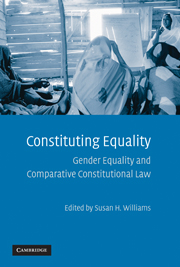Book contents
- Frontmatter
- Contents
- List of Contributors
- Acknowledgments
- CONSTITUTING EQUALITY
- Introduction: Comparative Constitutional Law, Gender Equality, and Constitutional Design
- SECTION ONE STRUCTURE
- 1 Gender Quotas in Politics – A Constitutional Challenge
- 2 Equality, Representation, and Challenge to Hierarchy: Justifying Electoral Quotas for Women
- SECTION TWO RIGHTS
- SECTION THREE CULTURE/RELIGION AND GENDER EQUALITY
- SECTION FOUR CONSTITUTIONS AND INTERNATIONAL LAW
- SECTION FIVE WOMEN IN THE PROCESS OF CONSTITUTION MAKING
- Conclusion: Gender Equality and the Idea of a Constitution: Entrenchment, Jurisdiction, and Interpretation
- Index
- References
2 - Equality, Representation, and Challenge to Hierarchy: Justifying Electoral Quotas for Women
Published online by Cambridge University Press: 26 October 2009
- Frontmatter
- Contents
- List of Contributors
- Acknowledgments
- CONSTITUTING EQUALITY
- Introduction: Comparative Constitutional Law, Gender Equality, and Constitutional Design
- SECTION ONE STRUCTURE
- 1 Gender Quotas in Politics – A Constitutional Challenge
- 2 Equality, Representation, and Challenge to Hierarchy: Justifying Electoral Quotas for Women
- SECTION TWO RIGHTS
- SECTION THREE CULTURE/RELIGION AND GENDER EQUALITY
- SECTION FOUR CONSTITUTIONS AND INTERNATIONAL LAW
- SECTION FIVE WOMEN IN THE PROCESS OF CONSTITUTION MAKING
- Conclusion: Gender Equality and the Idea of a Constitution: Entrenchment, Jurisdiction, and Interpretation
- Index
- References
Summary
Electoral gender quotas, although increasingly common, remain extremely controversial throughout much of the world. There is a lively debate in many countries over the justifications for quotas. And, as many observers have noted, the issues raised are remarkably similar, even in countries with very different political systems, and cultural and historical backgrounds. This chapter will explore the connection between the issue of justifying quotas, on the one hand, and models of equality and democratic representation, on the other.
The process of explaining why quotas are justified highlights a significant gap in current feminist models of equality and democracy. The majority of feminist writers call for a shift to particular models of equality and democratic representation as a basis for justifying quotas. Specifically, feminists tend to argue for a substantive model of equality rather than a formal one, and for a deliberative model of democratic representation rather than an aggregative one. My argument in this chapter is that we should supplement these models with an element that, although implicit in both models, needs to be more explicit and much stronger. This supplementary element involves challenging the reassertion of hierarchy and oppression. Adding this element of challenge to our models of equality and democratic representation will create a more effective justification for electoral gender quotas. And, equally important, adding this element of challenge will move us toward a stance that I believe to be important for feminism, both as a theoretical project and a political movement.
Information
- Type
- Chapter
- Information
- Constituting EqualityGender Equality and Comparative Constitutional Law, pp. 53 - 72Publisher: Cambridge University PressPrint publication year: 2009
References
Accessibility standard: Unknown
Why this information is here
This section outlines the accessibility features of this content - including support for screen readers, full keyboard navigation and high-contrast display options. This may not be relevant for you.Accessibility Information
- 4
- Cited by
